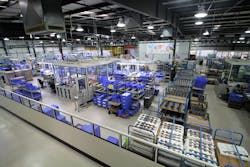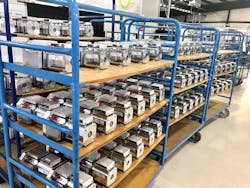Q&A with KNF Neuberger Inc.
Eric Wilson, director of sales and marketing, and Edward Budriss, senior manager of engineering, with KNF Neuberger Inc., discuss how COVID-19 is affecting their company and adjustments they are making to stay healthy and productive in their Trenton, New Jersey, facility. KNF manufactures application-specific pumps and systems.
What changes have you made to your internal company practices in response to the pandemic?
“All personnel not essential for production or support of production are working remotely,” said Eric Wilson, director of sales and marketing. “This required the purchase of additional IT equipment and for people to adapt quickly to remote work.”
Edward Budriss, senior manager of engineering, added: “We have moved all nonessential staff capable of work remote out of the office and purchased additional tools and equipment to support this effort. We have stepped up our cleaning of all common areas. We have engaged external cleaning services to help disinfect the facility and perform daily services. We promote the good work the team is doing and how critical it is to fight the COVID-19 pandemic. We work with suppliers to ensure they understand the criticality of the products that KNF produces and stay ahead of situations.”
Assuming roughly two months of this “new normal,” how much of an impact do you think there will be on your day-to-day work?
“The company’s use of collaboration tools has allowed for continued close communication — both internally and externally,” Wilson said. “Moving forward, the views of remote work will likely change forever. The new normal will be the more regular availability of remote work. If there was hesitancy or trust issues in the past, this situation has opened the doors forever.”
Budriss added: “We invested in cloud platforms and collaboration services several years ago and have remote work experience for most departments. We have found ways to migrate the last analog systems to digital solutions quickly in these past few weeks so all teams can work remote. The hardest thing is breaking the feeling of being disconnected. For this, we need to continue as if we were in the office, stand up meetings still occur, status meetings, we even have a digital break room where people can take a break for a few minutes. Use video conferencing when possible. We need to trust and rely on the team that is in the office as our eyes and ears. All the remote teams have nearly 100% functionality remotely. We rely on collaboration and communication tools to share information. As Eric mentioned, remote work will become more normal and accepted as we build trust and comfort.”
What are some initiatives your company has taken to protect workers while maintaining the business?
“We’ve staggered breaks and lunches to minimize the number of people together at once,” said Wilson. “We are spreading out at lunch time — multiple cafeterias, not gathering at tables together. We are not sitting side-by-side at desks and using other spaces when necessary.”
Budriss added, “All packages are quarantined for five days before the receiving team unpacks and distributes to the quality and production teams. We have mandated that all employees with the potential for remote work do so. We have stepped up cleaning of all common areas and brought in a daily cleaning crew to disinfect every night. We have increased the distance between production team members, and we have propped all doors open to help prevent transmission. All on-site employees are now wearing provided masks.
How do you think your job, in particular, can be handled during times of restricted personal interaction like these? What successes are you having in working with teams remotely?
“In sales, the team is familiar with remote work,” Wilson said. “It is critical to overcommunicate, and we have pushed for use of video chat whenever possible. We have established daily ‘coffee break’ sessions for anyone to join and socialize. Trying to fit some fun into the day is important. Also, lowering our expectations of professional standards a bit is necessary, as people are dealing with pets, kids, spouses, and uncomfortable workspaces.”
Budriss added, “The biggest thing is keeping the normalcy of daily activities. There is no canceling the meeting because we are remote. The video feature of our collaboration tools has been a huge help, and we rolled out headsets, which allow for great audio. This allows the full team to see gestures and read faces and hear comments clearly. The biggest success is being transparent in roadblocks, addressing them as a team and moving on. A particular hardship for the engineering team was the loss of witnessing R&D builds and testing. For this, we had to rely on the eyes and ears of our in-office R&D technicians and document items thoroughly. We also rotate one engineer into the office each day to provide any of the tactile feedback while limited team exposure.”
What seem to be the main threats to your supply chain right now?
“Customer demand is all over the place, and this is also creating havoc with supply chain,” said Wilson.
Budriss added, “Our products are produced from a global supply chain, and each area around the globe has been affected differently and at different stages. The supply chain team has engaged much of the organization (engineering, logistics, quality, etc.) to support parallel solutions for sourcing and validation. On some products, demand has dropped; on others, it has quadrupled. We need to organize and place effort where it is needed the most.”
How are you maintaining employee productivity? What about worker morale?
“For remote workers, it is important to maintain a feeling of inclusivity,” Wilson said. “It is also important to notice that how people react under stress may not be the same as normal circumstances. Personality and world view tend to shift to a very foundational level without much flexibility. Allowances and understanding are key in these circumstances, as is the need to cut each other some slack. Proactive communication is so important; the more you can get ahead of information, the less chance the grapevine will fill up with misinformation.”
Budriss added, “The biggest thing for essential office workers is positivity and safety. We should be vocal with respect and praise for the work they are doing while also listening to concerns for the health and safety of the team. As things change, we are transparent and pivot to the changing situation. As a management team, we try to stay ahead of situations and have plans for the ‘what ifs.’ When I am in the building, a smile or a conversation on how things are going (6 feet apart) go a long way in people feeling comfortable, relaxed and engaged. For remote workers, we need to recognize the tendency to feel a bit disconnected. We need to trust our team. We use collaboration tools, video chat, asking some light-hearted questions and listen to things that might need attention. Again, transparency of our current state and actions the company is taking are critical to stay in front of.
Have you had to beef up your networks if employees use cloud services?
“We switched from desktop to laptop computers in engineering and customer service,” Wilson said. “Remote workers who do not have company issued cell phones must use their own devices, and any additional charges may need to be looked at more closely once we resume normal operations. The collaboration tools have been working seamlessly, and it is great to see updates and improvements based on the additional usage of the tools.
Budriss added: “Most of the company was set up for remote work with the exception of engineering, which required higher-powered towers to run CAD and simulations. When the crisis hit, the first thing we did was purchase high-powered laptops for the team. We were already running a strong cloud backbone but had to get some of the slow adopters up to speed. The whole organization is still learning how to operate on the collaboration tools since we just can’t run down the hall to ask a question, but we get better each day. I am actually really impressed with the level of engagement and how seamless the technology has worked for us.”
How can engineers maintain their creativity during these times of limited physical interaction with other team members?
Budriss said, “Now more than ever, we have the need for engagement and open communication. We have a common engineering collaboration channel where we share all critical items, and the team can post questions and comments. Critical projects have separate channels, which the whole organization can access. We encourage private chats and video conferencing. Our R&D technicians have been great about adopting the tools and reaching out to the engineers working remotely. The engineering team has nearly 100% use of the same tools (CAD, simulations, etc.). We are currently rotating each engineer into the office one at a time to take care of the few items that must be done in office, support critical designs, and be the eyes and ears to support operations if needed.”What are the biggest issues customers and suppliers face and how are you addressing them?
Depending on where you are in the supply chain determines the amount of pressure you are feeling,” Wilson said. “The biggest issue is uncertainty, as we cannot plan a contingency for every possible situation, and some situations could be devastating. Constant, clear, and compassionate communication are necessary. We must have a collaboration mentality as this situation is showing the real meaning of supply chain — in that we are all part of the chain.”
Budriss added: “Part resource availability is our biggest issue. Our business was greatly affected by a surge in compressor demand for ventilators and respirators. We have seen a quadrupling in the demand overnight when many material suppliers are operating on reduced levels. Managing this requires a fully engaged supply chain team, engineering team, quality team, and management team. We all must work together. Daily status calls to report on changing environments and discussion of parallel sourcing plans.”
For the production/engineering departments, what challenges do they face? How has their job changed?
“The production team has a challenge to quadruple line throughput in some areas while maintaining safe distancing and employee safety,” Budriss said. “Employees have to take extra care to understand their health and stay home if they have certain symptoms for the benefit of all in the organization. We have placed a 5-day material quarantine for all incoming goods. This delays the inspection/acceptance of material and places a burden on the logistics team to quickly prioritize and move the right material quickly.
The engineering team faced some immediate challenges regarding our tools. The entire team utilized high-powered computers and was not able to work remote. We quickly purchased equivalent laptops and got the team remote. The engineering team is quite hands-on with our R&D technicians to ensure designs meet customer expectations. We now rely on video calls, pictures, etc., from the R&D technicians to support our projects. The team rotates into the office and is on call to support the operations team."

